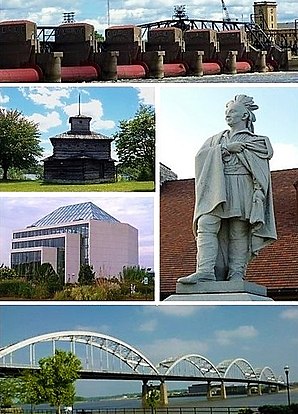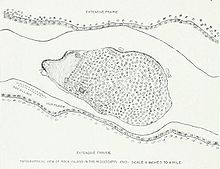Rock Island (Illinois)
| Rock Island | ||
|---|---|---|
 Images of Rock Island |
||
| Location in Illinois | ||
|
|
||
| Basic data | ||
| Foundation : | 1835 | |
| State : | United States | |
| State : | Illinois | |
| County : | Rock Island County | |
| Coordinates : | 41 ° 30 ′ N , 90 ° 34 ′ W | |
| Time zone : | Central ( UTC − 6 / −5 ) | |
| Residents : | 38,442 (as of 2006) | |
| Population density : | 933.1 inhabitants per km 2 | |
| Area : | 44.3 km 2 (approx. 17 mi 2 ) of which 41.2 km 2 (approx. 16 mi 2 ) is land |
|
| Height : | 171 m | |
| Postal code : | 61201 | |
| Area code : | +1 309 | |
| FIPS : | 17-65078 | |
| GNIS ID : | 416820 | |
| Website : | www.rigov.org | |
| Mayor : | Dennis Pauley | |
Rock Island is a city in the US state of Illinois and the county seat of Rock Island County . It belongs to the Quad Cities and is located directly on the Mississippi , which forms the border with the state of Iowa .
geography
Geographical location
Rock Island lies between the Mississippi River in the north and the Rock River in the south. The Rock River flows into the Mississippi on the west side of the city, so that the city is surrounded on three sides by flowing waters.
Neighboring communities
Just north of the city on the other side of the Mississippi is Davenport , which is already part of the state of Iowa . The two cities are connected by several bridges over the Mississippi. In the east, the urban area turns into Moline . Bettendorf is in the northeast . Because of their proximity, these cities are collectively called Quad Cities .
history
The area of today's city of Rock Island was inhabited by the Indian tribes of the Fox and Sauk until the beginning of the 19th century and the home of the famous chief Black Hawk . After the British-American War , the American army built Fort Armstrong on an island in the Mississippi that was named Rock Island. After the fort was completed in 1817, it became an important base. In the 1820s, Indians began relocating to the other side of the Mississippi. In the clashes that ended with the Black Hawk War in 1832 , the fort was even the military headquarters. One of the first settlers was the sutler George Davenport , who settled on the north coast of the island. The city maps for Rock Island and Davenport, which got their name from him, were later created in his house.
In the 1830s, more and more families settled near the fort on the mainland south of the Mississippi. On July 10, 1835, the settlement was declared a city and was named Stephenson . In 1839 the city's first newspaper announced that Stephenson had 175 houses and 600 residents, including three doctors and four lawyers. The city also has three taverns, several shops and a two-story courthouse. It was not until 1841 when it was officially registered as a town that Stephenson was renamed Rock Island . The city benefited from its location on the Mississippi and quickly became an important trading center. Most of the goods traffic was handled by steamships and around 1,900 boats headed for Rock Island each year. In the course of the brisk movement of goods, some industrial companies settled in the city area.
In 1854 Rock Island was connected to the rail network and the first railroad reached the city. The railroad company Chicago, Rock Island and Pacific Railroad built the first railroad bridge over the Mississippi in Rock Island in 1856, which the steamship operators did not like to see because the shipping of the river in the area of the bridge was considerably complicated. Just 10 days after the inauguration, the first accident occurred in which the bridge caught fire and was seriously damaged. In the ensuing legal battle, Abraham Lincoln represented the railroad company and obtained the bridge. In the following years Rock Island continued to grow and in 1875 Augustana College was inaugurated, the only college to date. In 1860 Rock Island already had over 5,000 inhabitants.
Between 1862 and 1886, a large-scale arsenal of the United States Army , the Rock Island Arsenal , was built on Rock Island . The island has therefore been called Arsenal Island since then . As early as 1863, during the Civil War , the area was used as a Union prison camp. A total of 12,192 Confederates were imprisoned there. Smallpox spread among the prisoners and 1,964 did not survive their imprisonment. The Confederate Cemetery is a reminder of this chapter of Arsenal Island. In 1898 during the Spanish-American War , the now completed arsenal was not only used for the storage and repair of military materials, but also for their production. The Rock Island Arsenal is now the largest US government-owned arms factory.
At the beginning of the 20th century, the gangster John Patrick Looney determined large parts of the city's affairs. He controlled gambling, alcohol smuggling during prohibition, and prostitution, and was the editor of the Rock Island News . The John Looney Legend Tour has existed since 2008 and takes you through the historical locations associated with Looney.
The film and television actor Eddie Albert (1906-2005) came from Rock Island .
In 1908 Longview Park was opened, a public park that was supposed to beautify the cityscape. The land was donated to the city by three business people for this purpose. The residents of Rock Island contributed to the costs through donations totaling US $ 125,000. The design came from the well-known landscape designer Ossian Cole Simonds. 15,000 visitors came to the inauguration ceremony.
During the First and Second World Wars , many workers came to Rock Island as the Rock Island Arsenal made and repaired materials for the war. The city received special permission from the government for the construction of additional houses and thus grew faster in the war years than in peacetime. Hundreds of buildings were built in 1918 and again from 1942 to 1944. The city continued to grow until the early 1960s. In 1960 Rock Island had 51,863 residents. However, due to high unemployment and poor infrastructure, the number of inhabitants fell to 38,442 in the following decades until 2006.
In 1965, the Mississippi River flooded for over a month, causing Rock Island to flood. In response to this flood, a dam was built between 1970 and 1973, which has shaped the cityscape ever since.
Population development
| year | population |
|---|---|
| 1839 | 600 |
| 1860 | 5,000 |
| 1960 | 51,863 |
| 1990 | 40,537 |
| 2000 | 39,684 |
| 2006 | 38,442 |
Attractions
Numerous bridges lead across the Mississippi to Davenport . The Swing Bridge Government Bridge transferred additionally the sluice gates of Lock and Dam No. 15 , which also includes the largest roller weir in the world. A little further downstream is another well-known bridge, the Rock Island Centennial Bridge . The Black Hawk State Historic Site has been located on a steep slope in the south of the city since 1987 , an area on which the Saukenuk village of the Sauk Indians was located. Saukenuk was the birthplace of Chief Black Hawk . Today, in addition to a large forest area, there is a museum and numerous historical sights on the site.
Personalities
sons and daughters of the town
- John Allred (* 1962), jazz trombonist and songwriter
- Aaron H. Grout (1879–1966), politician and lawyer
- Franz Jackson (1912-2008), jazz clarinetist
- Madison Keys (born 1995), tennis player
- Lissie (* 1982), folk-rock singer
- Gary Eugene Payton (* 1948), astronaut
- Samuel Rinnah Van Sant (1844–1936), politician and governor of the state of Minnesota (1901–1905)
- Henry Cantwell Wallace (1866-1924), professor, publisher, politician (United States Secretary of Agriculture)
Personalities who have worked on site
- George "Harmonica" Smith (1924–1983), blues harmonica player
- Teodors Celms (1893–1989), German-Baltic philosopher and university professor
Individual evidence
- ↑ Joe Nobiling: Rock Island, the Island ( Memento of the original from January 15, 2009 in the Internet Archive ) Info: The archive link was inserted automatically and has not yet been checked. Please check the original and archive link according to the instructions and then remove this notice. (English)
- ↑ a b c d Rock Island Preservation Commission: Rock Island History: A Companion to the Architectural Walking Tours , 1999 ( PDF ( Memento of the original dated November 29, 2010 in the Internet Archive ) Info: The archive link was inserted automatically and has not yet been checked. Please check the original and archive link according to the instructions and then remove this note. )
- ↑ a b Rock Island History ( Memento of the original from March 29, 2010 in the Internet Archive ) Info: The archive link was inserted automatically and has not yet been checked. Please check the original and archive link according to the instructions and then remove this notice. on the official website of the city
- ↑ Rock Island Arsenal's Role in Ordnance Production ( Memento of the original from January 11, 2010 in the Internet Archive ) Info: The archive link was automatically inserted and not yet checked. Please check the original and archive link according to the instructions and then remove this notice. on the Rock Island Arsenal website ( memento of the original from September 5, 2009 in the Internet Archive ) Info: The archive link was automatically inserted and not yet checked. Please check the original and archive link according to the instructions and then remove this notice. (English)
- ↑ John Looney Legend Tour ( Memento of the original from November 29, 2010 in the Internet Archive ) Info: The archive link was automatically inserted and not yet checked. Please check the original and archive link according to the instructions and then remove this notice. , PDF 2008 (English)
- ↑ a b Population figures of Rock Island on www.citypopulation.de
literature
- Rock Island Preservation Commission: Rock Island History: A Companion to the Architectural Walking Tours , 1999 ( PDF )




